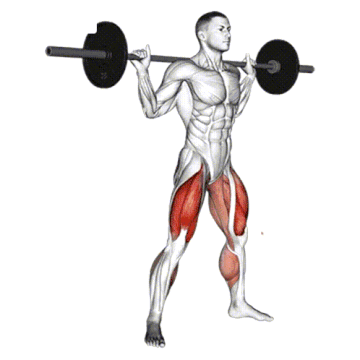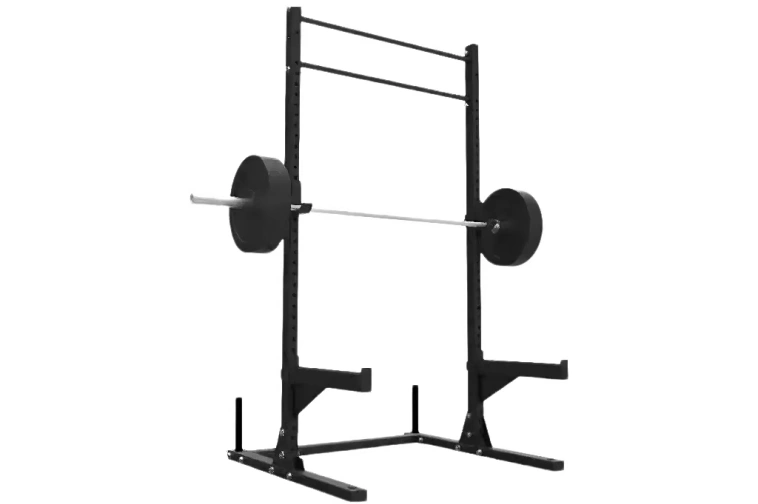How to improve squat — sounds easy.
But let’s be real. You’ve been training for months, and the bar just won’t move up. Knees feel a little off. Something about your form feels… wrong, but you can’t tell what. And your gym buddy? Just says “lower,” then shrugs.
Yeah, I’ve been in that exact spot.
You’re not lazy. You’re just missing a few key pieces.
This guide? It’s all about fixing that. Real stuff that works — for depth, control, power. Alright, let’s walk through it — one piece at a time.
Common Mistakes When Improving Your Squat
Wondering how to improve squat quickly? Start by fixing the basics. Most squat problems come from a few simple mistakes. You might not even notice them — until progress stalls or something starts to hurt.
Here are the big ones to watch out for:
1. Heels lifting off
Your heels pop up when you go down. That means your weight’s too far forward. Usually tight ankles — or too narrow a stance.
👉Feels like you’re tipping forward. No control, no power.
2. Knees collapsing in
Your knees cave in as you squat. Not good. It means your glutes aren’t firing, and your body’s looking for shortcuts.
👉Keep doing this, and your knees won’t be happy.
3. Rounding your back
Upper back rounds, or lower back dips. Either way, you’re losing core tension and risking your spine.
👉Looks shaky. Feels worse.
4. Not going deep enough
You think you’re low. But video says otherwise. Half squats = half results.
👉What looks “good enough” in the mirror… probably isn’t.
5. Rushing every rep
No pause, no control — just drop and bounce. You’re not building strength. You’re just getting through it.
👉Real strength is slow, steady, and sharp.
If any of this sounds familiar — good. Awareness is step one.
How to Improve Squat Form: The Basics You Can’t Skip
If you’re working on how to improve squat form, this is where it starts. Not with fancy gear or heavier weights. One clean rep is better than five sloppy ones.

Here’s what that looks like.
1. Start with how you’re standing
Plant your feet about shoulder-width. Toes slightly out — not straight ahead. This helps your hips move freely.
Too narrow? You’ll feel cramped.
Too wide? You’ll lose power.
Find a stance where you feel balanced, knees tracking your toes, and no weird foot twists.
2. Go deep — really deep
Lower until your hips are level with, or just below, your knees. That’s real depth.
Why it matters: deep squats hit your glutes and hamstrings.
Half reps? Mostly stress your knees — not in a good way.
3. Keep the bar over your midfoot
The bar should move in a straight line, right over the middle of your feet.
If it drifts forward, you’re probably leaning too much.
Stay upright and strong — that’s how you stay in control.
4. Brace like you mean it
Breathe into your belly. Now tighten your abs like someone’s about to punch you.
Loose core = unstable squat = sore lower back.
Good bracing keeps your spine safe and your squat solid.
5. Control every rep — no bouncing
Lower smooth. Pause briefly. Drive up strong.
Fast reps hide bad habits.
Slow reps build real strength.
Master these five points and you’ve built a strong base.
Still feel off-balance or can’t hit depth? Might be a mobility issue — let’s sort that next.
How Mobility and Flexibility Help You Improve Your Squat
Trying to improve your squat but feel like your body’s fighting you the whole way?
Not weak — just tight.
A lot of people think their squat is bad because of form. Truth is, your body might just be too stiff to hit a good position.

Here’s what usually holds you back:
🔴 Ankles too tight
If your heels lift up when you go low — it’s probably your ankles.
Can’t keep balance? Fall forward? Yup, same issue.
Try squatting barefoot with your heels on a small plate. Feels easier? Then you know.
🟡 Hips not opening
Tight hips = knees caving in, or you just can’t go deep.
You might feel stuck halfway down, or like your legs are jamming up.
Best fix? Sit in a deep squat (bodyweight) for 30–60 seconds a day. Simple but works.
🟢 Upper back won’t move
If your chest keeps dropping, especially with a bar, that’s your upper back being stiff.
Try wall slides or just do slow “cat-cow” stretches. You’ll feel the difference fast.
A stiff body makes good squats impossible — no matter how hard you try.
Add 5–10 minutes of warmup moves before strength training.
It’s not fancy. But it works.
Improve Squat Strength by Fixing Weak Spots
Your squat feels stuck. Not because you don’t know what to do — but because something in your body just isn’t strong enough to help.
Let’s break it down.

✅ Glutes (butt muscles)
Feels like: You come up from the squat and your hips shoot up first. Your chest falls forward. Bar feels heavier than it should.
Why? Your glutes aren’t pushing. They’re on vacation.
Fix it: Barbell Hip thrusts, glute bridges, step-ups — they all work. Just make sure you’re actually squeezing your butt, not letting your quads take over.
✅ Core (abs + lower back)
Feels like: You fold forward at the bottom. Your back feels soft or shaky.
How to tell: Try squatting and filming yourself — does your spine move a lot? That’s your core failing.
Fix it: Planks, bird dogs, or just bracing properly. Imagine locking your torso like a rock before you squat.
✅ Quads (front of thigh)
Feels like: You can’t push off the bottom. Knees ache. Everything feels heavy right away.
What to do: Front squats, split squats, or slow goblet squats — build strength through that tough first half.
✅ Hamstrings (back of thigh)
Feels like: You lose control on the way down. Or you overextend at the top.
Train it: Try some dumbbell (barbell) romanian deadlifts or good mornings — nice and slow. You want to feel that stretch in your hamstrings, not just move the weight.
Strength is specific. Find your weak link, and train it on purpose.
That’s how you stop “trying harder” — and start getting stronger.
Programming Tips to Improve Your Squat
Let’s be real — progress doesn’t work like that.
You need structure. A plan. Something that actually stacks over time.
Don’t worry — we’ll keep it simple.
📌 Step 1: Stick to 2–3 sessions a week
That’s enough. Any more, and your body can’t recover.
Split it like this:
- Day 1: Heavy squat (low reps)
- Day 2: Light or medium squat (more reps + control)
- Optional Day 3: Accessories only
You’re training strength, control, and skill — not just chasing big numbers.
📌 Step 2: Use the right reps and weight
| Focus | Weight Feel | Reps per set | What you're building |
|---|---|---|---|
| Power & strength | Heavy (hard but doable) | 3–5 reps | Raw strength & confidence |
| Muscle & control | Moderate (you feel the burn) | 6–10 reps | Muscle + better depth |
| Technique & form | Light (feels smooth) | 8–12 reps | Stability, balance, timing |
💡 Tip: You can mix them.
For example, open with your heavy sets — move some weight. Then finish with lighter, slower squats to really dial in control and position.
📌 Step 3: One plan, 3 to 4 weeks.
Stop switching things up every workout. Real gains come from repeating and improving.
Pick 2–3 squat variations. Track your weights. Try to beat last week — just a little.
You don’t need fancy spreadsheets. Just structure.
Train smart, rest well, lift better.
Do You Need Gear to Improve Your Squat
You’ve probably asked yourself:
Do I need lifting shoes?
Will a belt help me squat more?
What gear actually matters — and what’s just hype?
Here’s the truth:
👉 If you’re falling forward without a belt, slapping one on won’t fix the problem.
But once your form’s dialed in? Yeah — the right gear can help you feel way more solid and sure of yourself.
Let’s break it down — plain and simple.
| Tool | What it helps with | When you might use it |
|---|---|---|
| Lifting shoes | Helps you stay upright and balanced | If your heels lift, or your ankles are too tight to squat deep |
| Weight belt | Keeps your core tight under heavy loads | Use for top sets (80%+). Not for warmups or light work. |
| Knee sleeves | Adds warmth and light compression | If your knees feel stiff or clicky. Optional — not magic. |
| Wrist wraps | Supports your wrists in front squats or overhead work | Use if you feel strain — don’t rely on them just because. |
So… should you use gear?
If you can’t squat clean without all this stuff —
You don’t need gear. You need to build a better base.
Focus on this first:
Good form
Full depth
Solid core control
Once those are in place, gear can help you push further. Not before.
Stuck usually means something’s missing: control, balance, or strength in a weak spot. These variations help you find it — and fix it.
If you’ve hit a wall — maybe it’s not your effort. Maybe it’s just time to shift how you train.
We’ve covered the form, the mobility, the weak links, the structure, the tools, and the variations.
But at the end of the day, squatting better isn’t about doing everything.
It’s about doing the right things — consistently, patiently, and with intention.
You don’t need to impress anyone. You just need to improve you.
And that starts with your next rep.

Hi, I’m Alex Carter, part of the editorial team at Leadman Fitness. We specialize in crafting premium custom racks, cable machines, functional trainers, and strength accessories for home and commercial gyms. With a background in competitive powerlifting and gym design consulting, I’ve spent years testing gear under heavy loads and optimizing layouts for efficiency.
I focus on translating real-world user frustrations—like space limitations, budget constraints, or durability needs—into actionable solutions. By collaborating directly with our engineers and facility owners, I ensure our custom equipment evolves to solve the unspoken challenges lifters face daily. What I share isn’t textbook advice; it’s battle-tested insight from racks I’ve welded, cables I’ve replaced, and gym floors I’ve trained on.
